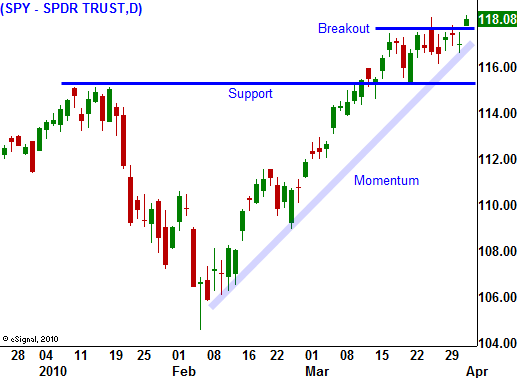Unemployment Report – Private Sector Is The Key!
In the last two weeks, the market has been very lackluster. It has traded in a narrow range on extremely light volume.
This week, the focus is on employment. Yesterday, we learned that the unemployment rate in Europe rose to 10%, the highest since 1998. Even Germany, its largest economy, saw unemployment rise to 7.5%.
The ADP employment index was also released yesterday. It measures employment in the private sector. Analysts had expected 40,000 new jobs and unfortunately, 23,000 jobs were lost. This was a huge miss and the market took the news in stride. The private sector is critical to an economic recovery.
Government debt continues to spiral out of control and our deficits have not gone unnoticed. Politicians and Americans (Tea Parties) are sickened by the burden we are leaving for future generations. The demand for our bonds during last week's auctions waned and that is a warning sign. New stimulus proposals will be hard-fought and the government has run out of ammunition. The Senate tired to pass unemployment benefit extensions ($9B) before they adjourned for holiday and due to overwhelming resistance, they did not.
We will see a temporary spike in federal employment as 200,000 census workers will be hired for a few months. There are still some stimulus programs that will create jobs, but most of those people have been hired. On the negative side of the ledger, US postal workers are being laid off and 30,000 are likely to lose their jobs. State and local governments are cutting payrolls at an alarming rate as funds run out. Public jobs are on the decline and this is why employment growth in the private sector is so critical.
Tomorrow, the Unemployment Report will be released. Analysts are expecting to see 190,000 new jobs. They have been calling for growth the last four months and each month, the economy has shown job losses. This could be the month that we finally move into positive territory. However, if most of the job growth is tied to the public sector, the reaction could be negative.
Corporations have trimmed the fat and with any topline growth, they will produce record profits. They do not want to add to overhead expenses and they are enjoying the spike in productivity. Multinationals are adding staff overseas where growth prospects are higher and wages are lower.
Domestically, our economy is dependent on consumption. Severance packages are running out and so are unemployment benefits. Baby boomers are at the brink of retirement and on average they have $80,000 saved. The need to cut back their spending and salt money away for their "golden years". Taxes will start popping up everywhere as state and local governments try to raise revenue. These factors will all influence spending.
From the Fed to individuals, everything has been borrowed from the future. The well is almost dry and the government can barely meet is mandatory expenses (interest and entitlement). States are $300 billion in the hole and they are out of money. Maine is considering a clown tax, Minnesota is considering a manicure and tattoo tax, California wants to tax Amazon and legalize pot! These are not rational decisions, they are acts of desperation. Homeowners borrowed equity against their home and now one out of every three is “under water”.
For the time being, everything is wonderful. Corporate profits are increasing, balance sheets are strong, interest rates are low and economic statistics point to a recovery. The market momentum has been powerful and today we are breaking out to new highs. The PMI in China and Europe is strong. Korean exports also grew at a fast pace. ISM manufacturing in the US came in at 59, much better than expected. With all of this good news, traders are discounting the problems that lie ahead.
Tomorrow's Unemployment Report is likely to show substantial job growth and the market will embrace it. However, the quality of new jobs will be suspect since most of them will come from the public sector. The market momentum is strong and you can't fight it. Optimism is extremely high and option implied volatilities are at 18-month lows. This means that speculators and hedgers are not buying puts. The sharpest corrections come when no one is expecting them.
Earnings season is approaching and that will fuel the rally. In October and January, the market advanced ahead of earnings releases. The news will be good and the market is likely to creep higher.
With every passing month, we get closer to a large decline. The credit concerns in Europe will heat up soon. The PIIGS countries will be issuing over €400 billion in debt in the next four months and weak demand will remind the market that a credit crisis in the EU looms. In a few months, employment concerns in the US will also start to surface.
There is a bit of money to be made on the upside and with the low implied volatilities; you have to be a call buyer. Limit you positions and keep your size small so that you can quickly exit the trades. Once we get through May, look out. I am much more interested the in trading the upcoming decline than I am in catching the last 3% of this rally.
As hard as this is to imagine, a sovereign credit crisis could make last year’s banking crisis look like a cake walk. Forty years of deficits and gratuitous entitlement programs are pushing the US, Japan and Europe closer to default as workers start to retire. These are the largest economies in the world. Watch the bond auctions in Europe and the US in coming months!


Daily Bulletin Continues...

